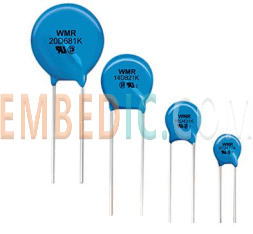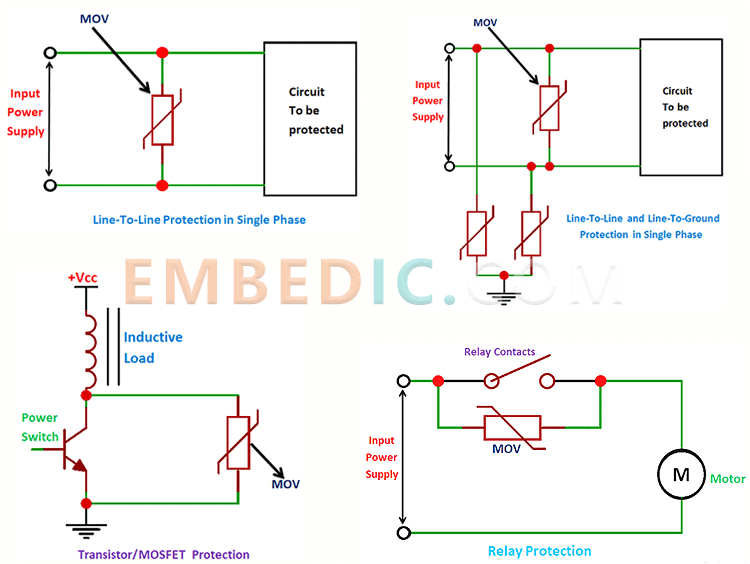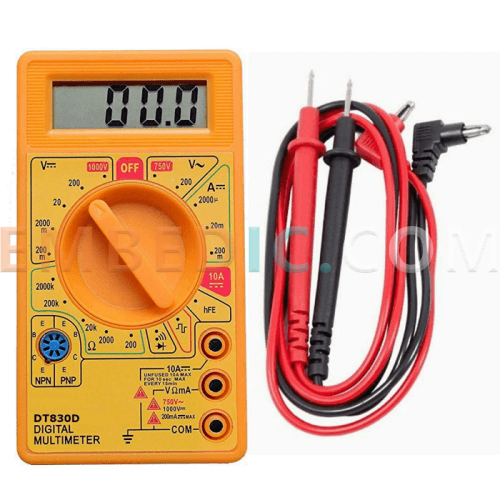If you are curious about varistor, today in this article, our team introduce everything news about varistor, such as what is a varistor, how does it work, how to test a varistor, even information about metal oxide varistors and the difference between Zener diode and varistor.
A varistor is a voltage-limiting protection device. Using the nonlinear characteristics of the varistor, when an overvoltage occurs between the two poles of the varistor, the varistor can clamp the voltage to a relatively fixed voltage value, thus realizing the protection of the back-end circuit. The main parameters of varistors are: varistor voltage, through-current capacity, junction capacitance, response time, etc.
The resistor body material of a varistor is a semiconductor, so it is a variety of semiconductor resistors. The zinc oxide (ZnO) varistor, which is used in large quantities, has a bivalent element zinc (Zn) and a hexavalent element oxygen (O) as its main material. Here's is the specification of varistor.
The MOV is simply a variable resistor, but unlike a potentiometer, the MOV can adjust its resistance according to the applied voltage. If the voltage across the resistor increases, the resistance decreases, and vice versa. This property helps shield circuits from high voltage surges, so they are often used as surge protectors in electronic networks. The figure below shows the basic MOV.

Under normal operating conditions, MOV resistances will be strong and they will absorb very little current, however, when a spike occurs in the network, the voltage will increase to a level that exceeds the knee or clamp voltage and they will absorb more current, thus eliminating the surge and providing protection to the device equipment. MOVs can only be used to defend against short term surges and cannot cope with long term surges. If MOVs are repeatedly subjected to surges, their performance may be slightly degraded. Whenever they are subjected to surges, the clamp voltage decreases slightly, which may also cause them to be damaged after a period of time. MOVs are usually connected in series with a thermal switch/fuse that can be triggered if a high current is required to protect against these types of risks.
MOVs can be used to protect different types of equipment from various types of faults. They can be used in AC / DC circuits for single-phase interline protection and single-phase interline and line-to-ground protection. They can be used for semiconductor switching protection in transistor, MOSFET or thyristor and contact arc protection in electric equipment.

When implemented, MOVs can be used in any circuit where surges or voltage spikes may occur. MOVs are typically used for surge protection in adapters and plugs, power connections for power supplies, telephone and other contact lines, industrial high energy AC line protection, data or power networks, general purpose electronic equipment protection such as cell phones, digital cameras, digital camera personal assistants, MP3 players and portable computers.
A varistor is a voltage-limiting protection device. Using the nonlinear characteristics of the varistor, when an overvoltage appears at both ends of the nonlinear varistor, the varistor can clamp the voltage at a relatively fixed voltage value, thus realizing the protection of the post-stage circuit.
The specific implementation process is understood: when the voltage applied to the two ends of the varistor is lower than its threshold voltage, the current flowing through it is extremely small, and it is equivalent to a resistor with infinite resistance. In other words, when the voltage applied to it is lower than its threshold value, it is equivalent to an open switch. When the voltage across the varistor is higher than its threshold voltage, the current flowing through it increases dramatically and it is equivalent to a resistor with infinitely small resistance. That is, when the voltage applied to it is above its threshold, it is equivalent to a closed switch.
Varistors are mainly used for transient overvoltage protection from lightning strikes, surges, etc. The biggest advantage of the varistor is that when the valve value of the varistor itself is greater than the voltage given to it externally, the current flow value in the circuit is very small and its own valve will be equivalent to a non-working valve. When the voltage increases, the resistance value in the circuit decreases and the current thus increases, which ultimately reduces the degree of influence of the voltage on the circuit. By this action, we can protect the circuit in the varistor and prevent the circuit from being affected by the voltage, so that the value of the voltage does not change too much.
For example, a zinc oxide varistor is used in the power supply circuit of a household color TV. The varistor used here has a voltage sensitivity of 470V, and when the maximum value of the transient surge voltage (not the effective value) exceeds 470V, the varistor reflects its clamping characteristics and pulls down the excessive voltage, allowing the post-stage circuit to work within a safe range.
Other applications.
1. You can use a suitable voltage source in series with a protection resistor to apply voltage to the varistor 4102 resistor, measure the voltage value of the varistor to see if it is on the nominal value, if it is, it can be considered that the component is good; If the weighing deviation is large, then there is a problem with this varistor.
2. Use a multimeter, set the gear position to 165310K, and connect the test leads to both ends of the resistor. The multimeter will display the resistance value of the varistor, and you can infer whether the varistor is damaged from the displayed value. However, the multimeter test is not very accurate.

3. Another method is to use an instrument, "varistor DC parameter meter" to test. This instrument is relatively accurate for testing. This instrument is specially designed for varistor testing.
A Zener diode, also known as a Zener diode, is a diode that operates in its reverse biased breakdown region and is therefore used for voltage regulation or voltage regulation limiting.
In the forward region, the Zener diode acts the same as an ordinary silicon diode, with a forward voltage drop of 0.7V during conduction; in the reverse bias region, the voltage is blocked until it reaches the Zener diode's voltage drop. breakdown voltage. At this point, the reverse current through the Zener diode increases sharply, but the Zener voltage across the device remains the same even as the Zener current varies.
Although the two have some similarities, they are fundamentally different. The varistor mainly plays a protective role. When there is a high voltage, the resistance value becomes smaller and the high voltage is discharged, but it does not have the characteristics of voltage regulation and is a non-polar element.
Zener diodes, also known as Zener diodes, break down when the reverse voltage exceeds the rated value and stabilize the voltage at a certain value. Zener diodes must be reversed and polarized when they are used as voltage regulators.
Manufacturer: Texas Instruments
IC DGTL MEDIA SOC 337NFBGA
Product Categories: SOC
Lifecycle:
RoHS:
Manufacturer: Texas Instruments
IC DSP FIXED-POINT 196NFBGA
Product Categories: DSP
Lifecycle:
RoHS:
Manufacturer: Texas Instruments
IC DSP FIX/FLOAT POINT 841FCBGA
Product Categories: DSP
Lifecycle:
RoHS:
Manufacturer: Analog Devices
IC CCD SIGNAL PROCESSOR 88LFCSP
Product Categories: DSP
Lifecycle:
RoHS:
Looking forward to your comment
Comment